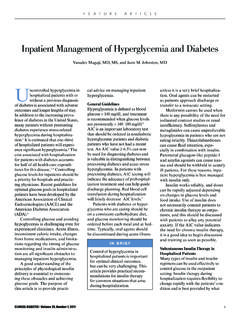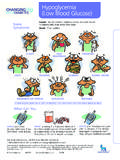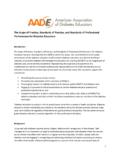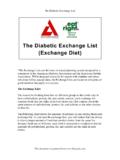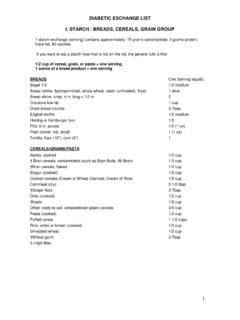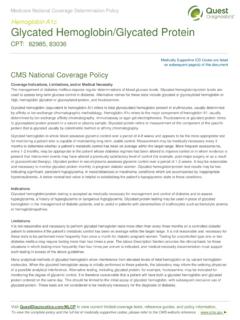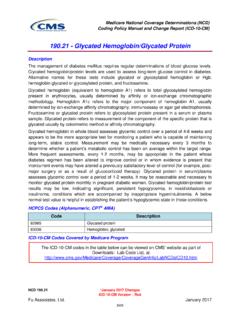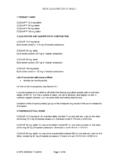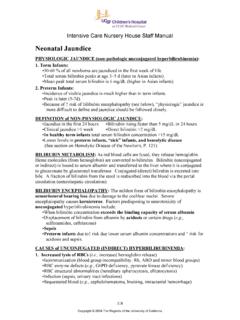Transcription of THE DIABETIC EXCHANGE LIST (EXCHANGE DIET)
1 THE DIABETIC EXCHANGE LIST ( EXCHANGE diet ). The EXCHANGE lists are the basis of a meal planning system designed by a committee of the American Diabetes Association and the American Dietetic Association. The EXCHANGE lists The reason for dividing food into six different groups is that foods vary in their carbohydrate, protein, fat, and calorie content. Each EXCHANGE list contains foods that are alike; each food choice on a list contains about the same amount of carbohydrate, protein, fat, and calories as the other choices on that list. The following chart shows the amounts of nutrients in one serving from each EXCHANGE list. As you read the EXCHANGE lists , you will notice that one choice is often a larger amount of food than another choice from the same list. Because foods are so different, each food is measured or weighed so that the amounts of carbohydrate, protein, fat, and calories are the same in each choice.
2 The DIABETIC EXCHANGE List Carbohydrate (grams) Protein (grams) Fat (grams) Calories I. Starch/Bread 15 3 trace 80. II. Meat Very Lean - 7 0-1 35. Lean - 7 3 55. Medium-Fat - 7 5 75. High-Fat - 7 8 100. III. Vegetable 5 2 - 25. IV. Fruit 15 - - 60. V. Milk Skim 12 8 0-3 90. Low-fat 12 8 5 120. Whole 12 8 8 150. VI. Fat - - 5 45. You will notice symbols on some foods in the EXCHANGE groups. 1. Foods that are high in fiber (three grams or more per normal serving) have the symbol *. 2. Foods that are high in sodium (400 milligrams or more of sodium per normal serving) have the symbol #. I. Starch/Bread List Each item in this list contains approximately fifteen grams of carbohydrate, three grams of protein, a trace of fat, and eighty calories. Whole-grain products average about two grams of fiber per serving. Some foods are higher in fiber. Those foods that contain three or more grams of fiber per serving are identified with the symbol *.
3 General rule: 1/2 cup of cereal, grain, or pasta = one serving 1 ounce of a bread product = one serving CEREALS/GRAINS/PASTA. *Bran cereals, concentrated (such as Bran Buds, All Bran) 1/3 cup *Bran cereals, flaked 1/2 cup Bulgur (cooked) 1/2 cup Cooked cereals 1/2 cup Cornmeal (dry) 2 1/2 tbsp Grape Nuts 3 tbsp Grits (cooked) 1/2 cup Other ready-to-eat, unsweetened (plain) cereals 3/4 cup Pasta (cooked) 1/2 cup Puffed cereal 1 1/2 cups Rice, white or brown (cooked) 1/3 cup Shredded wheat 1/2 cup *Wheat germ 3 tbsp DRIED BEANS/PEAS/LENTILS. *Beans and peas (cooked) (such as kidney, white, split, blackeye) 1/3 cup *Lentils (cooked) 1/3 cup *Baked beans 1/4 cup STARCHY VEGETABLES. *Corn 1/2 cup *Corn on the cob, 6 in. 1 long *Lima beans 1/2 cup *Peas, green (canned or frozen) 1/2 cup *Plaintain 1/2 cup Potato, baked 1 small (3 oz). Potato, mashed 1/2 cup Squash, winter (acorn, butternut) 3/4 cup Yam, sweet potato 1/3 cup BREAD.
4 Bagel 1/2 (1 oz). Bread sticks, crisp, 4 in. long x 1/2 in. 2 (2/3 oz). Croutons low fat 1 cup English muffin 1/2. Frankfurter or hamburger bun 1/2 (1 oz). Pita, 6 in. across 1/2. Plain roll, small 1 (1 oz). Raisin, unfrosted 1 slice *Rye, pumpernickel 1 slice (1 oz). White, Wheat, Whole wheat (including French, Italian) 1 slice(1 oz). CRACKERS/SNACKS. Animal crackers 8. Graham crackers, 2 1/2 in. square 3. Matzoh 3/4 oz Melba toast 5 slices Oyster crackers 24. Popcorn (popped, no fat added) 3 cups Pretzels 3/4 oz Rye crisp (2 in. x 3 1/2 in.) 4. Saltine-type crackers 6. Whole-wheat crackers, no fat added (crisp breads such as Wasa) 2-4 slices (3/4 oz). Whole-wheat crackers, fat added (such as Triscuits) 4-6 (1 oz). STARCHY FOODS PREPARED WITH FAT (count as 1 starch/bread serving, plus 1 fat serving). Biscuit, 2 1/2 in. across 1. Chow mein noodles 1/2 cup Corn bread, 2-in. cube 1 (2 oz).
5 Cracker, round butter type 6. French-fried potatoes (2 in. to 3 1/2 in. long) 10 (1 1/2 oz). Muffin, plain, small 1. Pancake, 4 in. across 2. Stuffing, bread (prepared) 1/4 cup Taco shell, 6 in. across 2. Waffle, 4 1/2 in. square 1. II. Meat List Each serving of meat and substitutes on this list contains about seven grams of protein. The amount of fat and number of calories vary, depending on what kind of meat or substitute is chosen. The list is divided into four parts, based on the amount of fat and calories: very lean meat, lean meat, medium-fat meat, and high-fat meat. One ounce (one meat EXCHANGE ) of each of these includes the following nutrient amounts: Carbohydrate (grams) Protein (grams) Fat (grams) Calories Very Lean - 7 0-1 35. Lean - 7 3 55. Medium-Fat - 7 5 75. High-Fat - 7 8 100. Lean Meat and Substitutes One EXCHANGE is equal to any one of the following items: Beef USDA Good or Choice grades of lean beef, such as round, sirloin, 1 oz and flank steak; tenderloin; and chipped beef#.
6 Pork Lean pork, such as fresh ham; canned, cured, or boiled ham#, 1 oz Canadian bacon#, tenderloin Veal All cuts are lean except for veal cutlets (ground or cubed) 1 oz Poultry Chicken, turkey, Cornish hen (without skin) 1 oz Fish All fresh and frozen fish 1 oz Crab, lobster, scallops, shrimp, clams (fresh or canned in water#) 2 oz Oysters 6 med Tuna# (canned in water) 1/4 cup Herring (uncreamed or smoked) 1 oz Sardines (canned) 2 med Wild Game Venison, rabbit, squirrel 1 oz Pheasant, duck, goose (without skin) 1 oz Cheese Any cottage cheese 1/4 cup Grated parmesan 2 tbsp diet cheese# (with fewer than 55 calories per ounce) 1 oz Other 95% fat-free luncheon meat 1 oz Egg whites 3. Egg substitutes (with fewer than 55 calories per 1/4 cup) 1/4 cup Medium-Fat and Meat Substitutes One EXCHANGE is equal to any one of the following items: Beef Most beef products fall into this category.
7 Examples are: all 1 oz ground beef, roast (rib, chuck, rump), steak (cubed, Porterhouse, T-bone), and meat loaf. Pork Most pork products fall into this category. (Examples: chops, 1 oz loin roast, Boston butt, cutlets). Lamb Most lamb products fall into this category (examples: chops, 1 oz leg, roast). Veal Cutlet (ground or cubed, unbreaded) 1 oz Poultry Chicken (with skin), domestic duck or goose (well drained of 1 oz fat), ground turkey Fish Tuna# (canned in oil and drained) 1/4 cup Salmon# (canned) 1/4 cup Cheese Skim or part-skim milk cheeses, such as: Ricotta 1/4 cup Mozzarella 1 oz diet cheeses# (with 56-80 calories per ounce) 1 oz Other 86% fat-free luncheon meat# 1 oz Egg (high in cholesterol, so limit to 3 per week) 1. Egg substitutes (with 56-80 calories per 1/4 cup) 1/4 cup Tofu (2 1/2 in. x 2 3/4 in. x 1 in.) 4 oz Liver, heart, kidney, sweetbreads (high in cholesterol) 1 oz High-Fat Meat and Substitutes.
8 These items are high in saturated fat, cholesterol, and calories. One EXCHANGE is equal to any one of the following items: Beef Most USDA Prime cuts of beef, such as ribs, corned beef# 1 oz Pork Spareribs, ground pork, pork sausage! (patty or link) 1 oz Lamb Patties (ground lamb) 1 oz Fish Any fried fish product 1 oz Cheese All regular cheese#, such as American, Blue, Cheddar, 1 oz Monterey, Swiss Other Luncheon meat#, such as bologna, salami, pimiento loaf 1 oz Sausage#, such as Polish, Italian 1 oz Knockwurst, smoked 1 oz Bratwurst#! 1 oz Frankfurter# (turkey or chicken) (10/lb) 1 frank Peanut butter (contains unsaturated fat). 1 tbsp Count as one high-fat meat plus one fat EXCHANGE : Frankfurter# (beef, pork, or combination) (400 mg or more of sodium per 1 frank EXCHANGE ) (10/lb). III. Vegetable List Each vegetable serving on this list contains about five grams of carbohydrate, two grams of protein, and twenty-five calories.
9 Vegetables contain two to three grams of dietary fiber. Vegetables that contain 400. mg of sodium per serving are identified with a # symbol. Vegetables are a good source of vitamins and minerals. Fresh and frozen vegetables have more vitamins and less added salt. Rinsing canned vegetables will remove much of the salt. Unless otherwise noted, the serving size for vegetables (one vegetable EXCHANGE ) is: 1/2 cup of cooked vegetables or vegetable juice 1 cup of raw vegetables Artichoke (1/2 medium) Eggplant Asparagus Greens (collard, mustard, turnip). Beans (green, wax, Italian) Kohlrabi Bean sprouts Leeks Beets Mushrooms, cooked Broccoli Okra Brussels sprouts Onions Cabbage, cooked Pea pods Carrots Peppers (green). Cauliflower Tomato (one large). Rutabaga Tomato/vegetable juice Sauerkraut Turnips Spinach, cooked Water chestnuts Summer squash (crookneck) Zucchini, cooked Starchy vegetables such as corn, peas, and potatoes are found on the Starch/Bread List.
10 For "free" vegetables ( , fewer than ten calories per serving), see the Free Food List. IV. Fruit List Each item on this list contains about fifteen grams of carbohydrate and sixty calories. Fresh, frozen, and dry fruits have about two grams of fiber per serving. Fruits that have three or more grams of fiber per serving have a * symbol. Fruit juices contain very little dietary fiber. The carbohydrate and calorie contents for a fruit serving are based on the usual serving of the most commonly eaten fruits. Use fresh fruits or frozen or canned fruits with no sugar added. Whole fruit is more filling than fruit juice and may be a better choice for those who are trying to lose weight. Unless otherwise noted, the serving size for one fruit serving is: 1/2 cup of fresh fruit or fruit juice 1/4 cup dried fruit Fresh, Frozen, and Unsweetened Canned Fruit Apples (raw, 2 in. across) 1. Applesauce (unsweetened) 1/2 cup Apricots (canned) (4 halves) 1/2 cup Banana (9 in.)
